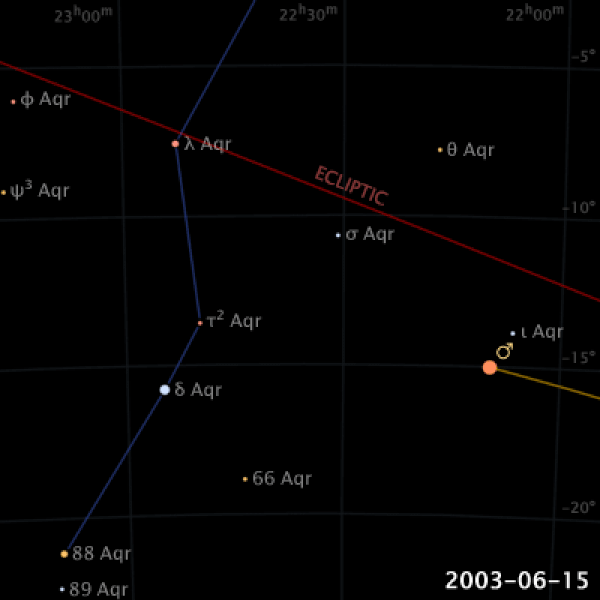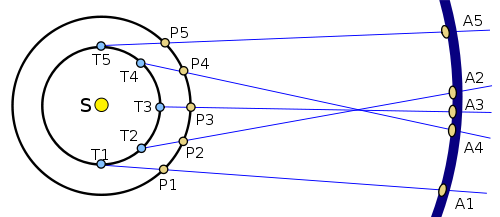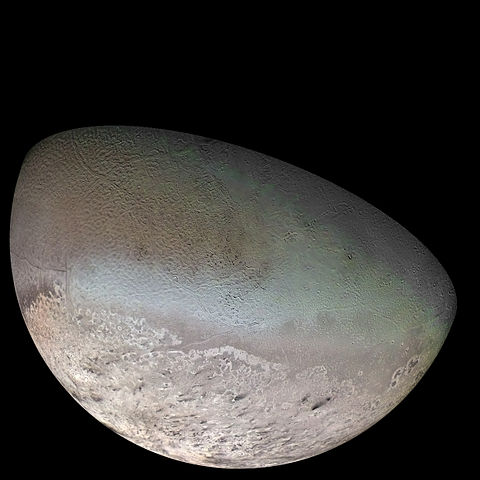Which Planets Exhibit Retrograde Motion

Some retrograde motility is an illusion
As measured against the fixed stars, planets typically appear to motion east. But, sometimes, they seem to intermission briefly in this eastward motility and, for some months, to move westwards (backwards) in front of the stars. Then they suspension again. Then they start moving eastward again. Astronomers (and astrologers) call their change in direction retrograde motion.
Though it baffled ancient stargazers, we know at present that this type of retrograde motion is an illusion.
You lot tin feel this illusion in an earthbound way, the adjacent time you pass a car on the highway. Equally you approach a slower automobile, it'south clearly moving in the same direction you are. Only, as yous pull alongside and laissez passer it – from your vantage point in the faster car – the slower motorcar may appear to move backwards for a moment. And so, as y'all pull ahead of it, the car appears to resume its frontward move.
The same matter happens equally World passes the slower-moving outer planets. When we pass Jupiter or Mars or Saturn, for example, these more outward planets in orbit – which move more slowly than Earth in orbit – appear to reverse grade in our sky.

It baffled early astronomers
Early astronomers believed Earth lay at the center of the universe. And so they went to complicated lengths to try to explain retrograde motion in that World-centered universe. They theorized each planet not just orbited Earth, but likewise spun effectually a moving point on their orbit known as an epicycle.
Imagine whipping a brawl on a length of string around your hand while yous turned in place. That's similar to the aboriginal view of retrograde move.
When it became more often than not accepted that World and the other planets orbited the sun, of a sudden retrograde movement made a lot more sense.

Retrograde motion on other worlds
If you could run into the heaven from another planet as well Earth, retrograde illusions would lead to your seeing some very foreign phenomena. On Mercury, for example, the sun sometimes appears to move in retrograde. Every bit Mercury speeds through its closest approach to the sun, its orbital speed overtakes its rotational speed. An astronaut on the surface would see the lord's day partially rise, and so dip back below the horizon, so ascension again before resuming its east-to-due west expedition beyond the heaven. The result is that, in one case a year, Mercury gets ii sunrises on the same day!
Other retrograde motion is existent
Astronomers also use the word retrograde to describe true backward motion among planets and moons.
Venus, for instance, rotates or spins on its axis in the opposite direction from every other planet in the solar organisation. If the clouds always parted, hypothetical Venusians would see the sun ascension in the westward and set in the east. Astronomers would say that Venus rotates in a retrograde manner.
Some moons also have retrograde orbits around their planets. In other words, near of the large moons orbit in the same management that their planet spins. But that's not true of Triton, for example, the largest moon of Neptune. It orbits reverse the direction of Neptune's spin.
Amid the smaller asteroid-like moons that swarm almost the behemothic planets, many accept retrograde orbits.
Information technology'due south the same word: retrograde. But now in that location's no illusion. Whether speaking of a planet'south rotation – or its orbit – if information technology's opposite what you'd expect, astronomers call it retrograde.

How does it happen?
According to modern astronomers, a true retrograde orbit for an orbiting moon most probable stems from a capture. Triton, for example, might have come out of the Kuiper Chugalug, the region of icy droppings beyond Neptune. Perhaps a collision in the chugalug sent Triton careening in toward the dominicus. A close come across with Neptune could have slowed it down, forcing information technology to settle into a backward orbit.
In past decades, astronomers have also discovered planets in distant solar systems with retrograde orbits. These exoplanets orbit their suns in the opposite direction from how the star rotates.
It'due south puzzling, because planets grade out of debris disks that orbit young stars. And those orbiting disks share the star's rotation. So how does a planet terminate up with a true astern orbit? The merely way – co-ordinate to today's astronomy – is either past a almost-collision with another planet, or if another star in one case passed also close to the system.
Either way, close encounters can disrupt the orbits of planets and fix them on a backward path!
Bottom line: Retrograde motion of Jupiter or Mars or Saturn in our heaven is an illusion, a play a joke on of perspective. Just in that location's a real retrograde motion, too.
Which Planets Exhibit Retrograde Motion,
Source: https://earthsky.org/astronomy-essentials/what-is-retrograde-motion/
Posted by: smithhower1967.blogspot.com


0 Response to "Which Planets Exhibit Retrograde Motion"
Post a Comment